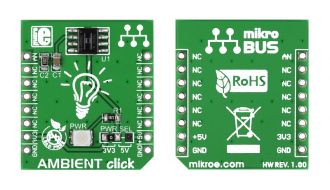
We strongly encourage users to use Package manager for sharing their code on Libstock website, because it boosts your efficiency and leaves the end user with no room for error. [more info]

Rating:
Author: MIKROE
Last Updated: 2019-03-18
Package Version: 1.0.0.1
mikroSDK Library: 1.0.0.0
Category: Optical
Downloaded: 5701 times
Followed by: 2 users
License: MIT license
Ambient click is an ambient light sensor carrying the Melexis MLX75035 IC. This chip consists of a photodiode, a transimpendance amplifier, and an output transistor. It converts the ambient light intensity into a voltage, using the mikroBUS AN pin for communicating with the target board microcontroller.
Do you want to subscribe in order to receive notifications regarding "Ambient click" changes.
Do you want to unsubscribe in order to stop receiving notifications regarding "Ambient click" changes.
Do you want to report abuse regarding "Ambient click".

Front and back view of the AMBIENT Click board designed in mikroBUS form factor.
View full imageLibrary Description
The library covers all the necessary functions to control the Ambient click board. Ambient click communicates with the target board via analog ( AN ) pin. This library contains drivers for reading ADC value of Melexis MLX75305 IC on Ambient click board.
Key functions:
Examples description
The application is composed of three sections:
void applicationTask()
{
valueADC = ambient_readADC();
light = ambient_calculateLightIntensity( valueADC, _AMBIENT_VCC_3_3, _AMBIENT_RES_12_BIT );
Delay_100ms();
WordToStr( valueADC, logText );
mikrobus_logWrite( " ADC value: ", _LOG_TEXT );
mikrobus_logWrite( logText, _LOG_LINE );
WordToStr( light, logText );
mikrobus_logWrite( " Light Intensity:", _LOG_TEXT );
mikrobus_logWrite( logText, _LOG_TEXT );
mikrobus_logWrite( " uW/cm2 ", _LOG_LINE );
mikrobus_logWrite( "-------------------", _LOG_LINE );
Delay_1sec();
}
Additional Functions :
Other mikroE Libraries used in the example:
ADCUART​ConversionAdditional notes and informations
Depending on the development board you are using, you may need USB UART click, USB UART 2 click or RS232 click to connect to your PC, for development systems with no UART to USB interface available on the board. The terminal available in all MikroElektronika compilers, or any other terminal application of your choice, can be used to read the message